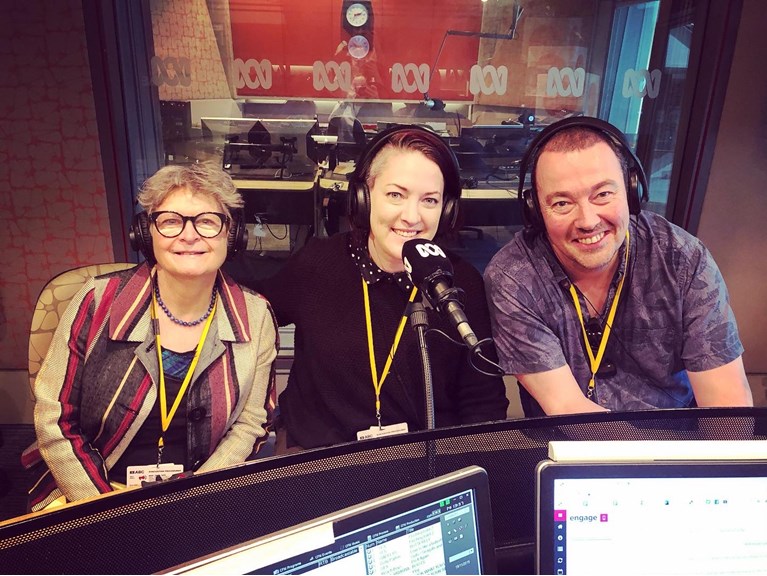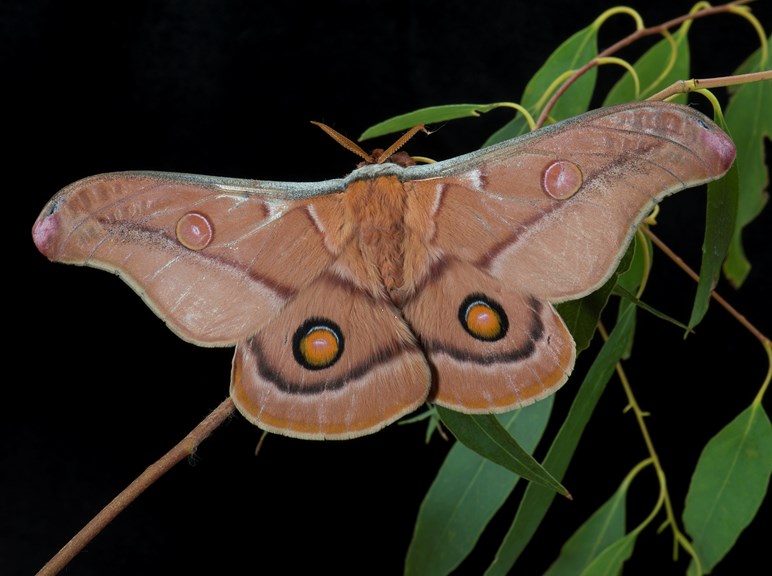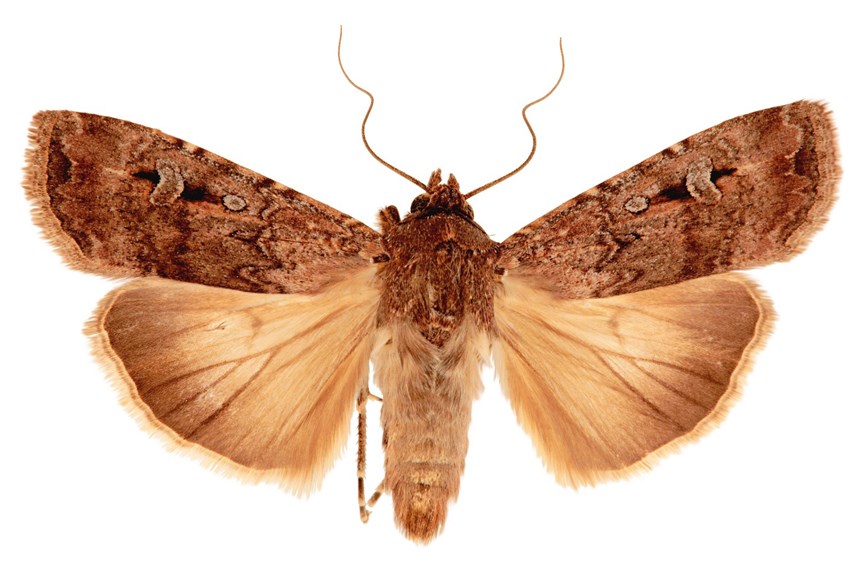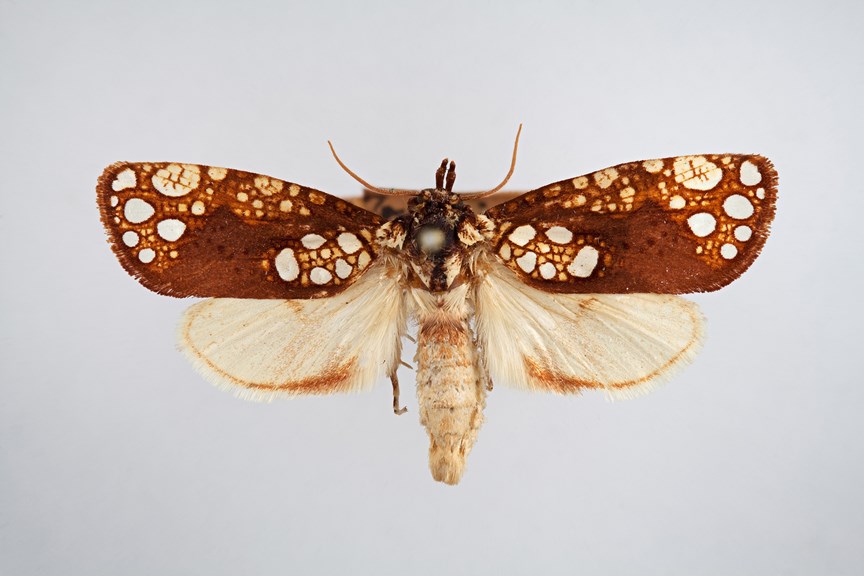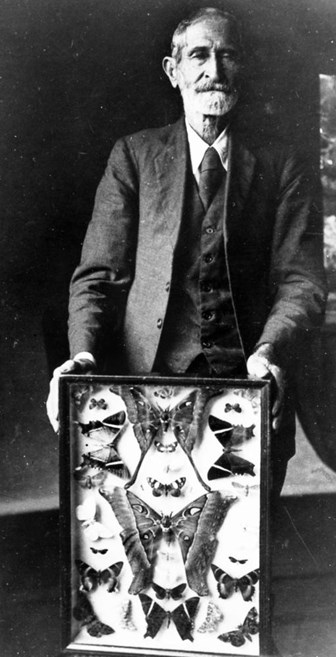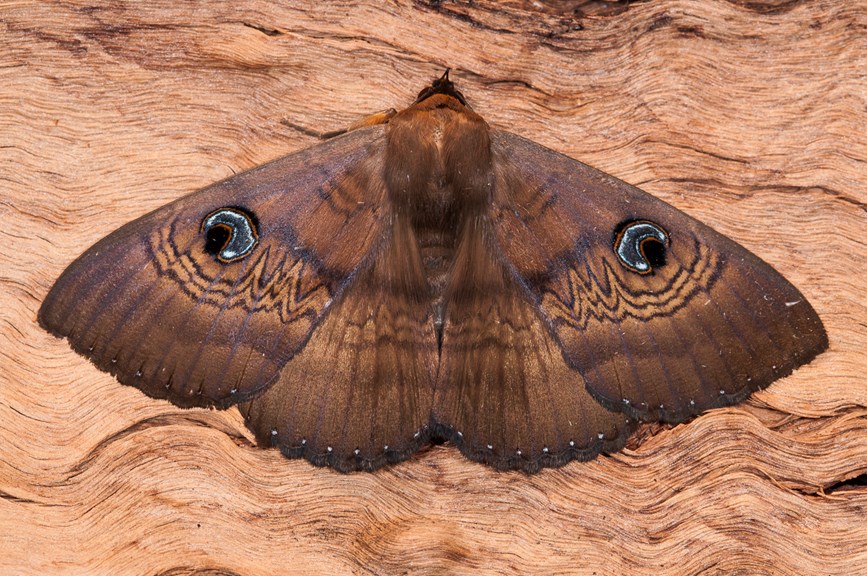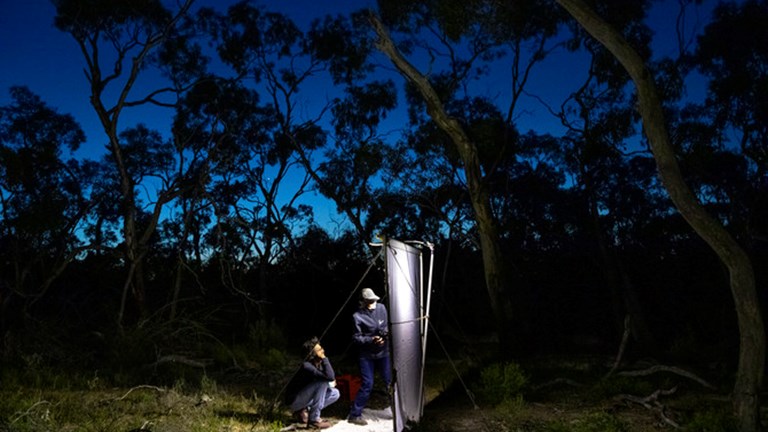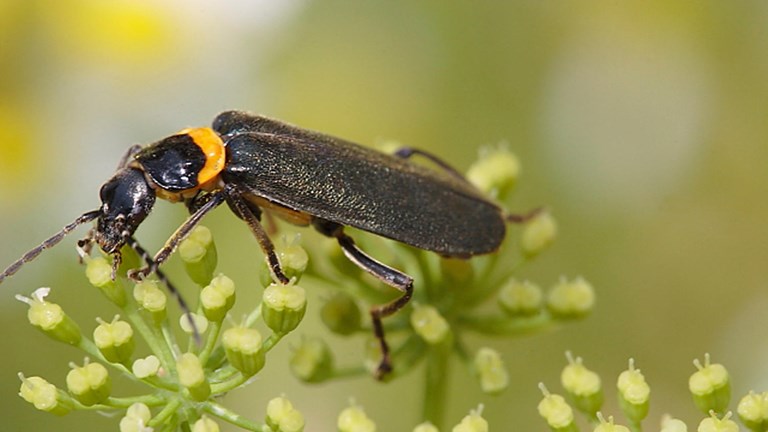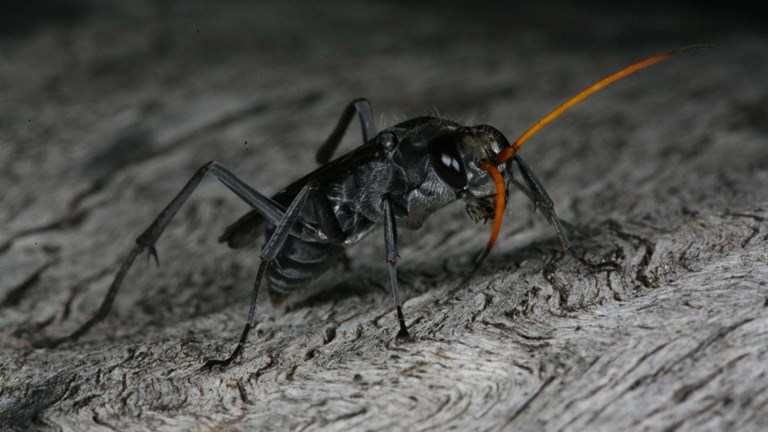On the wing
Simon Hinkley, Collection Manager, Entomology and Arachnology Collections at Melbourne Museum is a regular guest on Afternoons with Richelle Hunt on ABC Radio Melbourne. Simon contacted Chloe Strahan, Producer, ABC Radio Melbourne, about Professor Deirdre Coleman, University of Melbourne; and Nik McGrath, Archivist, Museums Victoria, joining him for a chat with Richelle about a McCoy research project, a collaboration between Museums Victoria and the University of Melbourne, linking letters with specimens in the George Lyell Collection. Studying George Lyell’s letters has enriched our understanding of the moths and butterflies George Lyell donated to the National Museum of Victoria (predecessor institution of Museums Victoria). The transfer of 12,000 butterflies and 40,000 moths from Lyell’s home in Gisborne (54km north-west of Melbourne), to the Museum in Melbourne was carried out between 1932 and 1946.
Simon, Deirdre and Nik were expecting some comments like ‘moths eat your clothes’, ‘how do you kill moths?’; ‘moths come out at night and they’re scary!’, and ‘moths aren’t as pretty as butterflies!’ We were pleasantly surprised about the positive response of listener’s sharing their memories and sightings of moths in Victoria. The following is a transcript of the interview, including links to resources and images to illustrate what was discussed on air, including some interesting talkback from ABC Radio Melbourne listeners. The Emperor Gum Moth was discussed at length, and many callers commented that they haven’t seen them as often as they did a decade ago, or for some, several decades. Simon has some interesting theories why that might be.
Hunt - “Today we’re talking about the George Lyell Collection (Moths are beautiful too) and can I say already there is a lot of love coming in [texts and calls from listeners] for moths. Does that surprise you?”
Hinkley - “It does a little bit and it’s actually really nice to hear that people are thinking about these beautiful moths. One of the things that Deirdre, Nik and I have been looking at in this [McCoy seed funded research project] is the incredible diversity in the moth fauna. There’s many more species of moths than there are butterflies. People often have a negative association with moths, so it’s really great to hear that people calling in are big fans.”
Hunt - “Before we get into this incredible research project that you’ve been working on, and the people, and the woman, in particular, behind it, there’s been a little bit of reminiscing about the Emperor Gum Moth [by callers], so I want to have a chat to Rosalind, who is in Dandenong. Hi Rosalind.”
Rosalind - “Hi, I grew up in Gippsland and they were a regular visitor, Emperor Gum Moths. They’ve got brilliant blue eyes on their wings, one-each side, but also with moths, tell your daughter, they have feather feelers. Butterflies only have dull knobs.”
Hunt and McGrath - *laughing*
Rosalind - “...and that powder is magic flying dust!”
Hunt - “Awww you’re good Rosalind, just when I thought I had a moment of parenting genius you came along with your magic fairy dust! That’s incredible. Have you always loved moths Rosalind?”
Rosalind - “I just like butterflies. But when was the last time you saw an Emperor Gum Moth? It’s the same as Christmas beetles, we no longer get those psychedelic Christmas beetles.”
Hunt - “I’m trying to remember that and lots of people are. I might put this to our guests. Nik, is this a moth... I mean some people like Chris, my earlier caller, said he hasn’t seen one in 50 years.”
McGrath - “I remember as a little girl growing up in Brisbane we used to see a lot of butterflies in the backyard and I think I have seen much less butterflies and moths generally, you know, as growing up… I don’t know if you feel the same way as this Simon, do you think you’re seeing less in your backyard gardens and things like that?”
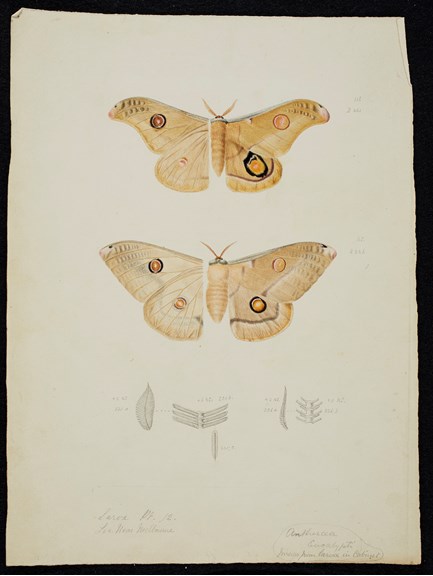
Hinkley - “The Emperor Moth one is a really good question. … It’s a large moth, and it’s a beautiful moth, people are very aware of it and we do get quite a few enquiries at the Museum of people saying ‘when I was a kid’, that thing of ‘I saw a lot more of them’. And they love peppercorn trees, so whether or not we’ve lost some of the peppercorn trees in Melbourne is a possibility. One possible theory is that European wasps take a large percentage of the caterpillars. So it could be introduced insects, as well, at play in the apparent reduction of populations. Christmas beetles is another one that we get with people saying ‘where are they?’, ‘when I was a kid you saw them’. Whether it was a matter of when they were kids they were out in the ground, on the ground looking for them…”
Hunt - “digging around”
Hinkley - “or the populations have actually declined, possibly a little bit of both.”
Hunt - “Let’s talk about Lyell. This is part of the research and collection project in collaboration with Melbourne University. Who was George Lyell, Deirdre?”
Coleman - “He was someone who started collecting around the age of 18 and collected to the end of his very long life. He lived outside Melbourne in Gisborne, and he amassed an enormous collection, and much bigger collection than any that was held in the Museum.”
Hunt - “What period are we talking here, when was he collecting?”
Coleman - “Early 20th century. He became ill in his 60s and he decided that he had to do something about this massive collection, so he spent, luckily he lived for another 20 years, because he needed all that time to relabel, and reassemble this massive collection and donate it to the Melbourne Museum. Simon can talk about the scientific importance of the collection, in terms of understanding biodiversity today, and just understanding what it is that we’ve lost in terms of the different kinds of butterflies and moths.”
Hunt - “A step back from that though, it obviously then gets donated, documented and becomes part of a museum or research project. But prior to that, where is he keeping it all. With collectors, with researchers, I’m always fascinated by how they are actually putting that body of work together when it’s not in a museum.”
McGrath - “So he worked in Cherry & Sons, so he actually worked in a manufacturing firm, and he actually built his cabinets and drawers, which we still actually have in the Museum, in the collection store where Simon works, these beautiful beautiful drawers. So in the letters there’s descriptions where he used every available space in his house, and even towards the end of his life, and sadly when he passed away, there were drawings sitting around waiting to come back to the Museum. So any available floor space… His children were his butterflies and moths, he didn’t actually have children, so these were his babies. I think he spent every waking moment, besides he was working full time at Cherry & Sons, but every waking moment outside of work he spent on his collection.”
Hunt - “What was he trying to discover? Was it that he just loved and wanted to build a collection? Was there something he was trying to get to the bottom of?”
McGrath - “I think he was addicted to collecting. When he was unwell, in his letters, he talked to Waterhouse, who he was very close to, who lived in Sydney, and he was also a fellow collector, he spoke about the weather, or if the weather was bad I can’t go out in the field to collect, or if the weather wasn’t right, the moth or the butterfly wasn’t on the wing because it was storming, they discussed the weather more because of their collecting, and their addiction to collecting. Being in bed and being unwell would have been upsetting to him, and later in life, wanting to be out in the field, walking and finding his moths and butterflies… Something else that’s interesting is that he was also an orchid collector. So he was a fastidious man, he loved being in the field and being outside and picking these little items that you wouldn’t notice if you were going on a walk in the field, but he was a man that would notice these things.”
Hunt - “So how has the work of George Lyell helped you in your work, Simon, as Entomologist at Melbourne Museum?”
Hinkley - “It’s really important because what the Museum’s collection is, it’s a historical and contemporary collection, it’s a species list in space and time. The important thing here is the label data, without that it’s just a moth or a butterfly. It’s interesting, to pick up on something Nik was saying. Often when you’re looking at these labels, it will say ‘collected on 25 December 1924’... So these people were out on Christmas day when the rest of us are gorging on food and presents. They’re out going it’s a nice sunny day, let’s get some moths. They were really dedicated. I like, what they’ve done with that collection, as Deirdre was saying starting in the early 20th century, you have a species list from a place and a time…. Gisborne…. You can go back now and do a survey, we can say these 25 species of moths that were there a hundred years ago are now gone. That’s the value of a historical collection. You know what was there and what’s been added, what’s flown in that wasn’t there, due to possible climate change or accidental introduction, or what was the indigenous fauna that is not there due to whatever reasons.”
Hunt - “You always wonder when someone is collecting, creating a collection of this scale if they are thinking generations down the track, and I’m not just collecting them because they’re beautiful. One day this body of work will help people, like the three of you here, conduct your research. Do you think that goes through their mind?”
Coleman - “I’m not so sure. I think the aesthetic of the butterfly and the moth is really important, and you see that in their letters. I’m a literary scholar, and so I’ve mainly been looking at the letters. They are themselves ephemera like moths and butterflies. There is this rich archive at Melbourne Museum is just wonderful as a scholar to get in there read and understand the interactions between this mainly male coterie...”
Hunt - “Wow, you deep dived in the manuscripts. Good on him for documenting. What a good man, not only was he collecting all these things we can look at down the track, the documentation and the manuscripts involved… It was very rare for a woman to be working in this field, but there was one woman, and her story is incredible. Her name is Miss J Kong Sing, tell us about her.”
McGrath - “I was really intrigued when I found her name in the “Butterflies of Australia” manuscript which you can actually find on the Biodiversity Heritage Library. So, if you’re interested, look for “Butterflies of Australia”, it was published in 1914, George Lyell co-authored with his friend, Waterhouse, he was just called Waterhouse by Lyell. When I was looking at the manuscript I saw Miss J Kong Sing on one of the illustrations, and then I found this whole story, I did a bit of a dive in Trove. I’m not sure if listeners are interested in Trove, but you might be aware, check out Trove, it’s a great place to find newspaper clippings and lots of information. So I actually did a dive.”
Hunt - “You went down a rabbit hole…”
McGrath - “I went down a rabbit hole, definitely, I found out that Miss J Kong Sing was a miniature artist, she did these amazing portraits. She lived in Sydney, she was Chinese descent, she actually ended up going back to Europe, she lived in Spain for ten years, then lived in London for ten years. She did these amazing portraits of important personalities. But one thing she did was these beautiful illustrations that were in this beautiful publication, which I encourage you to check out. A lot of men, of course, are involved in the publication but one important woman. I don’t know her first name, I only know J, I don’t know her first name. I’ve been doing a lot of digging, but I want to find out a bit more about her, her story, and also I’d love to find out what she looks like. If I could find a photograph of her, or an image of her, that would be amazing.”
Hunt - “I love it when we throw a mission out there to listeners, you’ll never know what might come back. Simon Hinkley is with you, Entomologist from Melbourne Museum, Nik McGrath is an archivist at Museums Victoria, and Professor Deirdre Coleman, Robert Wallace Chair of English, School of Culture and Communication at the University of Melbourne. Together they have put together a research project about George Lyell Collection (Moths are beautiful too). I just want to go through… I have text after text of images of some really beautiful moths and sightings. ‘Richelle and guests, this was on my flywire just the other morning, it’s an Emperor Gum I think, we see them occasionally’... And this is a beautiful earthy stone coloured moth. It says ‘Richelle, Simon and guests, here are some more moths from last night in the Yarra Ranges. I saw an Emperor Gum Moth, huge, flying around the street just last night. I haven’t seen one in Victoria for more than ten years. I blame European wasps, they are pure evil.’ Can’t love everything, I guess, can you?!”
Hinkley - “I have to agree with that one!”
Hunt - “Yeah… ‘how could you not love the Bogong moth, Rich?’ says Chris in Newborough, and he sent a gorgeous little picture. I’m not sure how he managed to get so close, must have a very good camera, to that particular species. How many species, roughly, would we have here in Melbourne and Victoria?”
Hinkley - “I think nationwide we’re looking at about ten thousand described species of moths.”
Hunt - “Yowsers!”
Hinkley - “And we’re looking at butterflies in the hundreds. Certainly diversity is far and away skewed to the moths’ side. But because they’re predominantly nocturnal, we generally see the butterflies because we’re out during the day. We’re probably looking at in excess of twenty thousand moths once everything is described and published. A diversity factor of ten times at least between butterflies to moths. Just to make it confusing there are moths that fly during the day. There are a whole lot of cross-over things that make it a little difficult. They’re really really beautiful.”
Hunt - “Why are they so drawn to light? They’ll gather around a light outside your house. Why is that?”
Hinkley - “It’s probably got something to do with the moon as a tracking or navigational thing. That’s why one of the best things searching for moths is to go outside and look at your porch light. Or see when you’re washing the dishes the things that are flapping against the kitchen window. So, they are drawn because the lights we have at ground level are generally brighter than the moon, so they get sucked into coming in to see us. That’s not really what they want to do, bang themselves against the window.”
Hunt - “They’re not really happy to see us.”
Hinkley - “No, but one thing I really did like in this project, and one of the great things about having an archive, is that I don’t really dive into that sort of thing, I’m looking after the physical collection. Nik and Deirdre are going back looking at all the correspondence. For example, one of the things I didn’t know was that George Lyell had an orchid collection. So that was good for me to know. I think when Nik went to the Botanic Gardens some of the people there were like, ‘was he into insects?!’ Some of the people at both institutions were unaware of that other level of info. It was great for Nik to go through and find this information that I was unaware of. It’s been a really interesting project.”
Hunt - “How much has the art of collecting changed over the decades?”
Hinkley - “Good question, we were actually discussing that when walking over from the Museum and whether or not you could have people like this again. Deirdre was researching Dodd, and that was how he made his money. He collected and sold insect specimens. That was his full time job.”
Hunt - “They wouldn’t be able to do that now.”
Hinkley - “Exactly, so now there are a lot of species listed on the CITES [Convention on International Trade in Endangered Species of Wild Fauna and Flora] list which prohibits the trade in endangered species. In the old days there is nothing wrong with you saying ‘hey, Washington I have ten Emperor Gum Moths, I’ll have fifteen of your Monarchs and swap away. Now if a species is listed as threatened, you’re not legally allowed to trade it. You can’t go into a National Park and collect. All native flora and fauna in national parks and reserves is protected. So that’s why there is a lot of people now doing ... citizen science is often image based. People taking images like you’re receiving, whacking them up on websites going ‘what’s this?’ We go, ‘that’s a so and so’. It’s a really good way for people to get engaged without old fashioned killing methods, and grabbing moths and all sorts of things.”
Hunt - “I love hearing the stories of when Simon receives a package, and he opens up the envelope and there is alive or not so happy creature of some sort. How many moths do you get sent to you in the mail?”
Hinkley - “I get a lot of clothes moths sent in, which is a nice easy one because I can just say ‘that’s a clothes moth and not a great thing’. Generally the good stuff is images that is taken out in the forest and is hard to collect. A clothes moth is right there in your carpet going crazy so people pick it up and send it in. So the stuff that is outside is more interesting. I tend to get only images. The boring stuff is generally what comes through the post.”
Hunt - “I just love it! What a crazy job! You know when you have a work experience or intern come to you work, I would be saying, ‘could you just open this mail for me please?’”
Hinkley - “I have had a boss in the past who did scream because we had a large moth sent in. It had emerged but its wings were all crumpled. It hadn’t extended. So she opened it, and all she saw was a large dark moving thing. So she thought it was a large spider. So she squawked. We don’t encourage live stuff being sent through the mail, by the way. Occasionally people don’t get the message.”
Hunt - “I just can’t believe that you could get spiders sent in the mail. Sounds like my idea of a life of punishment, really. How is this particular research project and collection available to the general public, if schools, enthusiasts, individuals want to learn more about this?”
Coleman - “Well Nik’s been doing a great job of blogging throughout the year.”
McGrath - “Please find our blog, we’re planning to do some more blogs, as well, and you can have a look at the history of the project and how it’s developed over the last year, but also what we’re planning to do in the future. So we’re planning to do some more publications on this as well. Do a search under our names on the Museums Victoria and University of Melbourne, and the George Lyell Collection. We also suggest you have a look on the website, on the Museums Victoria Collections website, a number of the collection items from George Lyell’s Collection are digitised, a lot of the type specimens been digitised. Is that correct Simon?”
Hinkley - “When we talk about type specimens, that’s basically if a new species is going to be described, the scientific author has to nominate a particular specimen as the type specimen. Any future researcher has to refer to the type specimen, so they are scientifically really important. So the Museum has a large number of types from the George Lyell Collection. We have been trying to digitise as many of them as we can.”
McGrath - “It’s in the hundreds.”
Hunt - “Wow, that’s amazing. I love it when many hands together make these great collections that we can all benefit from. Deirdre, just finally, in the work that you do at Melbourne University in the School of Culture and Communication, did you ever think you would be deep diving on moths?”
Coleman - “Not at all. I’m a literary scholar. It’s just in the last ten years I’ve been working in natural history. Really focusing on letters and communities of collectors. As Nik said, collecting is an addiction, it’s an obsession, I’ve become a bit obsessive too about these extraordinary characters, these entomologists.”
Hunt - “These characters that come out of it. The literary side of it. Their backstory, their obsession, their passion, and their documentation.”
Coleman - “Their very obsessive and fastidious and perfectionists and their really unique individuals. Sometimes they form very close bonds but they are also a very competitive group. So I love the insights we get from the letters. How a community of entomologists was … Chaps out there in the field and the more sedentary museum professionals and the way they are slightly looking down on their noses in the early twentieth century on those field collectors. But Frederick Parkhurst Dodd, who Simon mentioned, was someone who made a living, he had a large family, he had been a bank teller, gave it up, he had a secure job in the bank, he gave it up to be in the bush to collect. He had a very profitable career, he was selling.”
Hunt - “And a nicer lifestyle than working in a bank.”
Coleman - “Exactly, he was just dying away in the bank, I think, he needed to get out into the bush. He was selling very large exotic butterflies and moths to Rothschild Tring outside London. He was an international as well as national dealer.”
Hunt - “Have films been made about this?”
Coleman - “There should be films about entomologists. They are very fascinating.”
Hunt - “We came up with the idea here.”
McGrath - “We could be your researchers.”
Coleman - “We’ll be in it!”
Hunt - “Guest cameos. More royalties. However we can see it. Congratulations, I could talk about this all day. Do we have a favourite moth or butterfly if you had to pick one?”
Coleman - “The Dugeonea, I think, which Dodd found and George Lyell said towards the end of his life after the donation was complete, he was asked which was his favourite, of all his collection, which was tens of thousands of moths and butterflies, and he cited this moth that Dodd had found in Townsville.”
Hunt - “What does it look like?”
Coleman - “It’s just an exquisite creature. It’s on our blog.”
McGrath - “It’s on our blog, we’ve have a photo. It looks like rain drops, it could be on a garment, it’s just the most gorgeous thing. Brown motley, silver, gorgeous circles. It’s really worth looking at our blog. This is interesting, because you just found out it still exists, or possibly exists.”
Hinkley - “I thought it had been, or I should have known being the entomology side of things, that it had not been seen since Dodd collected it in 1902, and I was having a look on the Atlas of Living Australia which takes records from a whole range of people, and it was cited again in 2010. So for more than a hundred year’s Dodd’s collection from one site up in northern Queensland was the single record of this species. Happily someone has found it again. So whether or not just that nobody was looking for it, or it is just that rare, or a bit of both. But it is lovely to know that what was his favourite is still flying around.”
Hunt - “Just quickly, what is your favourite?”
McGrath - “It’s really hard to pick a favourite, but I think some of the larger specimens really are bizarre and freaky. So moths that get to the size of your hand. It never occured to me that they would get that big, and I can’t imagine seeing them flying around my face. They are some of my favourites, I think.”
Hunt - “Simon?”
Hinkley - “I wasn’t expecting the question, yeah there’s ten thousand to pick from. I really like, possibly the not politically correctly called Old Lady Moth. The one you get in your house with two eye spots, it’s quite large. I remember as a kid that was the one that came inside quite a bit. I was always quite impressed because it was quite large and I didn’t know what it was.”
Hunt - “It must mean that they are awesome and rockin because Old Ladies have it going on. It has been wonderful having you all here. Simon Hinkley, Entomologist, Melbourne Museum; Nik McGrath, Archivist, Museums Victoria; Professor Deirdre Coleman, School of Culture and Communication at the University of Melbourne. Thank you so much for introducing us to the George Lyell Collection (Moths are beautiful too). We have been talking butterflies, how could we not play Dolly Parton, ‘Love is Like a Butterfly’.
The George Lyell Collection: Australian Entomology Past and Present McCoy Seed Funding Project is led by Professor Deirdre Coleman, School of Culture and Communication at the University of Melbourne. Nik McGrath, Archivist, Museums Victoria, is the coordinator at Museums Victoria, with colleague Simon Hinkley, Collection Manager, Entomology and Arachnology.
Written by Nik McGrath, Archivist, Museums Victoria
If you’re interested in learning more about the project, see our previous articles Butterflies of the night, Like moths to a flame, Pressed Orchids, The sting of the final letter, Light sheets, Kindred spirits and Moths are beautiful too.
